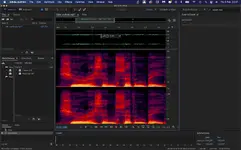This notch just made no sense - with some research I can't find any examples of this phenomenon happening, so I did a different test.
Using the Tascam interface (one I am totally happy with), there is the notch at 6.8K.
Today, I put the SM7B in front of loudspeakers producing pink noise and recorded into the interfaces available to be here:
Tascam 1641 - a black line, not that deep but visible at 6.8K ONLY on SM7B - SM58 used as comparison, notch free.
Zoom H6 - no notch visible at all on either mic
Midas M32 - again, no notches.
The conclusion is the notch is produced in the Tascam, and further testing of the Tascam using NO microphone, but simply normalising the preamp noise reveals some quite unpleasant spikes, produced internally. Without the normalisation they are totally inaudible, but maybe there are not just spikes, but notches, and the extra gain required with the SM7B raises them above the noise floor so they can be seen, if not heard? There is no notch I can detect on the SM7B using a different preamp/interface, but it is there on the Tascam.
If anyone has time to waste, and has a DAW that can normalise - pull out your mic connector and record the silence and normalise it. If you have a spectrum scope or or other tool in a menu somewhere - I discovered Cubase's spectrum display today for the first time - this gives a simple line graph of level vs frequency and the spikes are quite pronounced. Lots of the little peaks are mathematically linked, I note - so a little peak every two KHz indicates perhaps internally generated artefacts - in the preamp, or DAW I do not know, but it is interesting.



 . What a strange discovery. Thanks everyone!
. What a strange discovery. Thanks everyone!